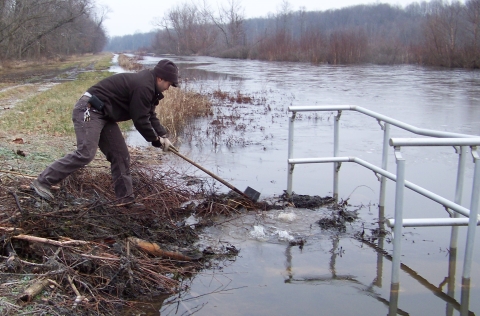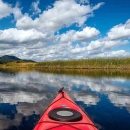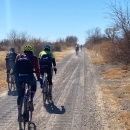Management and Conservation
Prioritizing Wise Infrastructure Investments
Infrastructure is always degrading: As one problem is fixed, others develop. Service structures are particularly vulnerable to deterioration because of remote field locations and the increasingly destructive effects of climate change climate change
Climate change includes both global warming driven by human-induced emissions of greenhouse gases and the resulting large-scale shifts in weather patterns. Though there have been previous periods of climatic change, since the mid-20th century humans have had an unprecedented impact on Earth's climate system and caused change on a global scale.
Learn more about climate change . To repair and maintain its vast portfolio, the Service receives about $170 million a year in appropriations.
The Service maximizes the impact of funding it receives by leveraging other funding sources, prioritizing built assets based on use and condition, making strategic investments, using maintenance action teams, and disposing of unneeded structures.
A Life-Cycle Management Approach
The Service works toward a life-cycle approach to infrastructure management. This proactive approach emphasizes regular scheduled maintenance instead of deferring maintenance to failure. The industry standard for estimating the cost to maintain assets in good condition is 2%-to-4% of current replacement value (CRV). Through our approach, if fully funded in the right sub-activities, we can maintain the Service infrastructure portfolio at 1.3% of CRV—well below the industry standard.
Our strategic approach uses the following criteria to prioritize investments:
Alignment with long-range plans and objectives.
Reduction of the deferred maintenance backlog, environmental liabilities and operational costs.
Ability to leverage multiple funding sources, including the Federal Lands Transportation Program, the Great American Outdoors Act Great American Outdoors Act
This landmark conservation law, enacted in 2020, authorizes the use of up to $1.9 billion a year in energy development revenues for five years for needed maintenance to facilities and infrastructure in our wildlife refuges, national parks, forests, recreation areas and American Indian schools.
Learn more about Great American Outdoors Act , and supplemental funds. For example, the Refuge System has used 102 Federal Lands Access Program awards totaling $156.5 million to support gateway communities.Projects on 101 urban national wildlife refuges and stations with the highest visitation. These sites account for 80 percent of Refuge System recreation use and more than one-third of the total deferred maintenance backlog.
Use of partner resources. For example, through a partnership with the Union Sportsmen’s Alliance, we have received thousands of volunteer hours from highly skilled union trade workers.
In addition to the above criteria, Great American Outdoors Act projects are selected based on the ability to quickly deploy funds.
A Long-Term Vision
Extreme heat events, flooding, wildfires and intense storms can damage or destroy infrastructure, creating repair expenses and lost access. The Service proactively plans by assessing vulnerabilities and implementing strategies to reduce future potential impacts. The Service uses a data-driven assessment of vulnerability and the most current construction methods to withstand the increasing frequency and intensity of natural disasters.
Example:
Anahuac and McFaddin National Wildlife Refuges in Texas
Texas coast refuges survived Hurricane Harvey in 2017 with relatively minor damage — even after the storm stalled over the coast for days and caused a thousand-year flood — because of the Service’s smart actions after an earlier storm.
In 2008 Hurricane Ike hit the upper Texas Gulf Coast, devastating the entire administrative infrastructure at McFaddin and Anahuac National Wildlife Refuges.
In response, the Service adopted tougher acquisition and construction practices, building facilities at higher elevations and to more stringent wind and storm standards.
The emergency command center at Winnie Depot remained high and dry throughout the 2017 storm.
Economic Benefit
A $1 investment generates $3.12 in economic activity.
The $42.9 million deferred maintenance appropriations generates $133 million in economic value plus 768 jobs in state and local economies.
Deferred Maintenance Backlog
By investing limited resources in projects with the largest return on investment, the Service has reduced its maintenance backlog by 50 percent since 2010.
Year Maintenance Backlog (in Millions)
2010 $2,711
2011 $2,706
2012 $2,544
2013 $2,398
2014 $1,747
2015 $1,284
2016 $1,165
2017 $1,178






